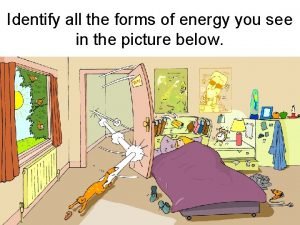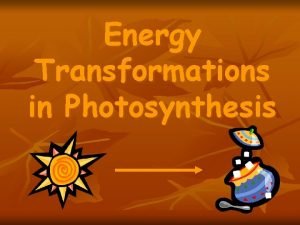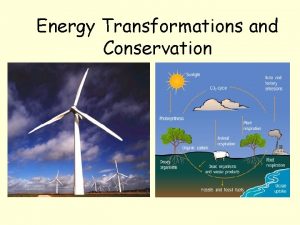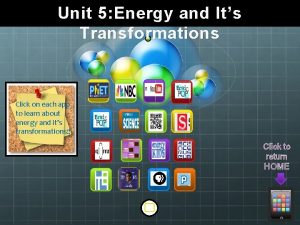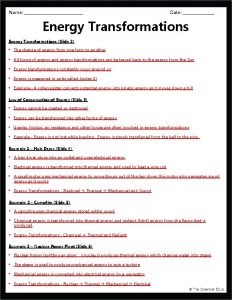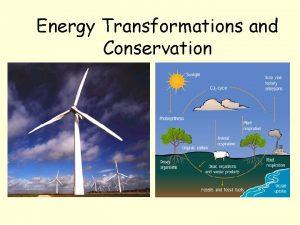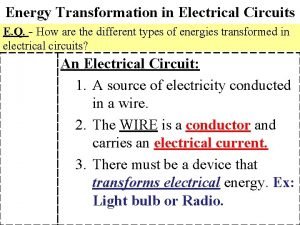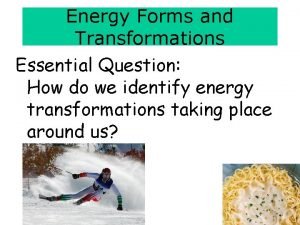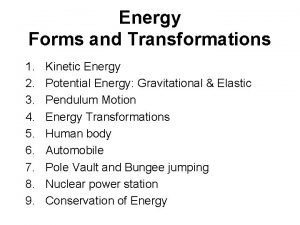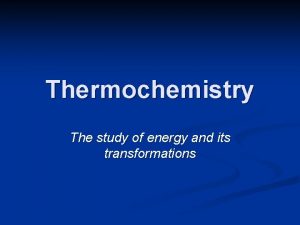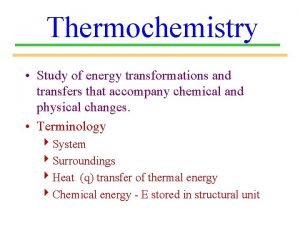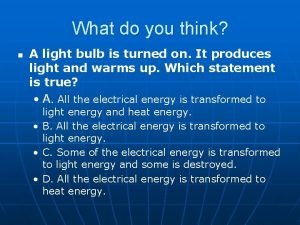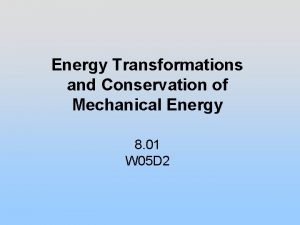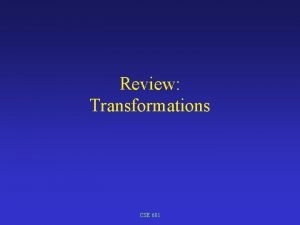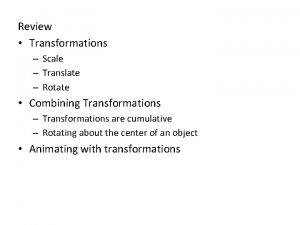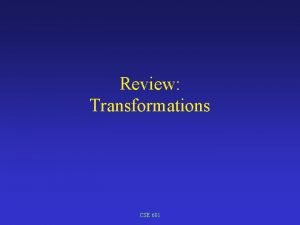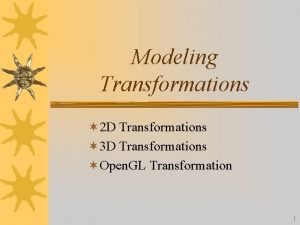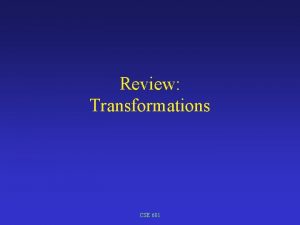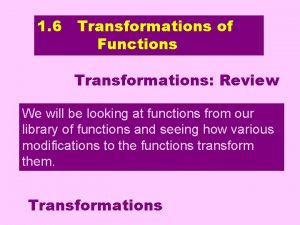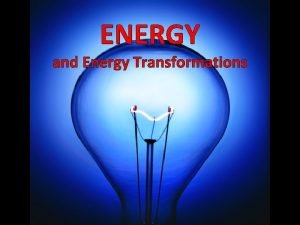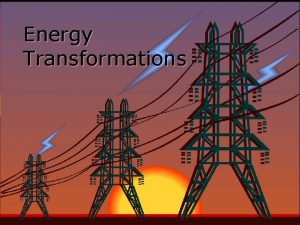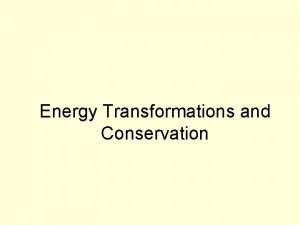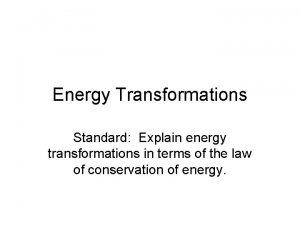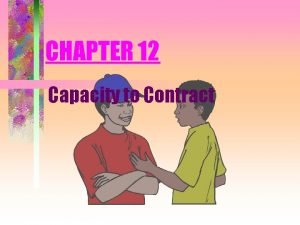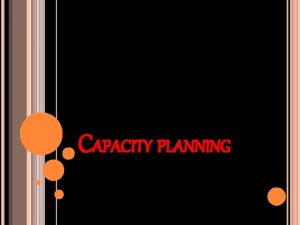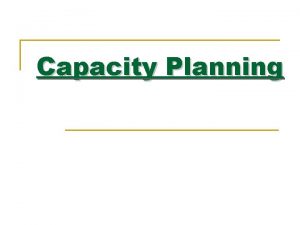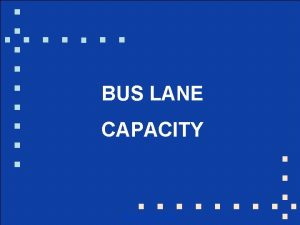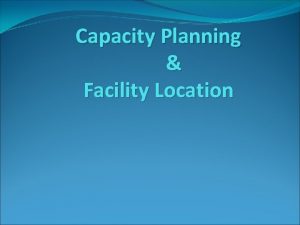ENERGY ENERGY TRANSFORMATIONS Energy E The capacity to















![Example A worker pulls a heavy cart with a force of 40 N [E] Example A worker pulls a heavy cart with a force of 40 N [E]](https://slidetodoc.com/presentation_image/36e521551adf628c441c1fcb33602bd9/image-16.jpg)













- Slides: 29

ENERGY & ENERGY TRANSFORMATIONS

Energy (E) • The capacity to do work (more to come in a couple slides)

• All forms of energy can be classified into one of two broad categories: Kinetic Energy (energy of motion) Potential Energy (stored energy)

Forms of Energy • Use the internet to prepare a definition for the following types of energy and classify them as kinetic or potential: Chemical Gravitational Kinetic Sound Elastic Electrical Nuclear Thermal Radiant

Energy Transformation Equations • Energy cannot be created or destroyed, only transformed from one type to another • Energy transformation equations show energy changes throughout a process • Energy transformation equation for a microwave: electrical radiant thermal Arrows indicate a transformation

Create Energy Transformation Equations for: (simple) • A child jumps on a trampoline • A portable CD player operates with a battery • An incandescent light bulb is switched on • A rollercoaster climbs and descends the first hill • A person playing an electric organ presses a key and we hear the note played

Create Energy Transformation Equations for: (complicated) • A nuclear core heats up water to the boiling point which turns a generator • Spring with a mass attached is pulled down and then released (moves up and down until it comes to a rest on it’s own) • A match is struck against a matchbox and ignites

Work (W) • The energy transferred to an object by an applied force over a measured distance • WORK is ENERGY TRANSFERRED

You can think of energy as … • • The ability to do work Work waiting to happen

The Work-Energy Equivalence • In general, doing work gives an object energy AND an object that has energy can do work. • Both Energy and Work have the unit Joule (with a capital “J” = N. m)

The following conditions must be met in order for work to be done: 1. ) A force must be exerted on an object 2. ) The object must be displaced (moved) by the force 3. ) At least part of the force must be in the same direction as the displacement

Examples • A person lifting a box from the floor to the table • A person pushing a box along the floor from one spot to another

What is Work? • In Physics, work has a very specific definition • Is this work? ▫ Video

Work • Energy transferred to an object over a distance • WORK IS ENERGY GAINED OR LOST W=FΔd Where: W – Work (J) F – Magnitude of Force (N) d – distance (m)

W = F∆d Important Notes: • Work is scalar – directions are ignored for F and d • This equation is used for 1 D problems only • Work is measured in N∙m = J (Joule)
![Example A worker pulls a heavy cart with a force of 40 N E Example A worker pulls a heavy cart with a force of 40 N [E]](https://slidetodoc.com/presentation_image/36e521551adf628c441c1fcb33602bd9/image-16.jpg)
Example A worker pulls a heavy cart with a force of 40 N [E] for 5. 0 m [E]. What is the work done by the person?

W = F∆d = (40 N)(5. 0 m) 2 = 2. 0 x 10 J

Positive Work • When the force is in the same direction as the displacement • "+" work = force tends to increase the energy of the object

Negative Work • If the force is opposite to the direction of the displacement (i. e. friction) • "-" work = force tends to decrease the energy of the object

Example A 42 kg child runs and then slides 7. 8 m along an iced over pond. The coefficient of kinetic friction between the child's boots and the ice is 0. 0050. a. ) What is the force of kinetic friction acting on the child? b. ) Calculate the work done by the kinetic friction

Solution a. ) FK = μKFN FN = Fg = mg =(42 kg)(9. 8 m/s 2) = 4. 1 x 102 N FK = (0. 0050)(4. 1 x 102 N) = 2. 1 N

b. ) W = F∆d = (2. 1 N)(7. 8 m) = 16 J

Work Done Against Gravity • Lifting an object to a higher position means you are working against gravity which is exerting a downwards force on that object • If the velocity of the object being lifted is constant, than Fnet acting on the object is 0. Therefore, FA = F g

Example A 23 kg box is lifted 1. 2 m from the floor to a desk with no acceleration. Determine the work done on the box.

FA = Fg = mg = (23 kg)(9. 8 m/s 2) = 225 N W = F∆d = (225 N)(1. 2 m) = 2. 7 x 102 J

Who thinks they can do zero work? • Hold a textbook at arms length

Zero Work (ZERO Energy Transferred) • Exerting a force but 0 displacement ▫ a student holding another student on their shoulders • Force is 0 but displacement occurs ▫ a puck on an air table (no friction) • Displacement is perpendicular to the force ▫ a javelin thrower runs with the javelin above their head Fa

Challenge Question Who will do more work? A. ) 2 people lifting a piano into the back of a truck OR B. ) 2 people pushing the same piano up a ramp to the back of the same truck

Homework! • Create two questions with full solutions
 Design capacity and effective capacity examples
Design capacity and effective capacity examples What energy transformations take place during digestion?
What energy transformations take place during digestion? Identify the energy conversions in the illustration below
Identify the energy conversions in the illustration below Radiant energy photosynthesis
Radiant energy photosynthesis Conservation and transformation of energy
Conservation and transformation of energy Study jams kinetic energy
Study jams kinetic energy 7 types of energy
7 types of energy Identify the energy transformations that occur in a guitar
Identify the energy transformations that occur in a guitar Energy transformation and conservation
Energy transformation and conservation Energy transformation in a simple circuit
Energy transformation in a simple circuit Energy forms and transformations
Energy forms and transformations Energy transformation
Energy transformation The study of energy and its transformations.
The study of energy and its transformations. Study of energy and its transformations
Study of energy and its transformations What is 4 step energy transformation of a flashlight?
What is 4 step energy transformation of a flashlight? Mechanical energy meaning
Mechanical energy meaning Hình ảnh bộ gõ cơ thể búng tay
Hình ảnh bộ gõ cơ thể búng tay Frameset trong html5
Frameset trong html5 Bổ thể
Bổ thể Tỉ lệ cơ thể trẻ em
Tỉ lệ cơ thể trẻ em Voi kéo gỗ như thế nào
Voi kéo gỗ như thế nào Glasgow thang điểm
Glasgow thang điểm Hát lên người ơi alleluia
Hát lên người ơi alleluia Môn thể thao bắt đầu bằng chữ f
Môn thể thao bắt đầu bằng chữ f Thế nào là hệ số cao nhất
Thế nào là hệ số cao nhất Các châu lục và đại dương trên thế giới
Các châu lục và đại dương trên thế giới Công thức tính độ biến thiên đông lượng
Công thức tính độ biến thiên đông lượng Trời xanh đây là của chúng ta thể thơ
Trời xanh đây là của chúng ta thể thơ Cách giải mật thư tọa độ
Cách giải mật thư tọa độ Phép trừ bù
Phép trừ bù


